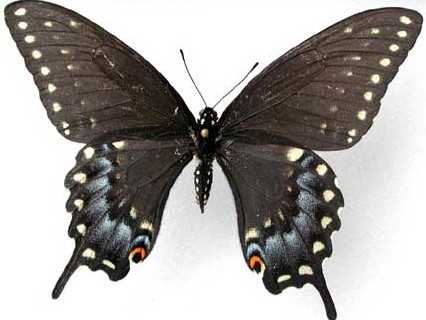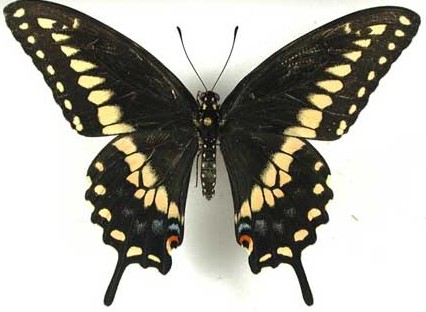The eastern black swallowtail is found in eastern US from the Atlantic Ocean to the Rockies into Arizona and and Mexico. It inhabits open areas such as suburbs, gardens, farmland, meadows, fields, deserts, marshes and the banks of watercourses; rarely in woodlands. The dorsal wing surface of both males and females is blue-black with two orange eyespots surrounding black dots at the corner of the hind wings toward the body. Males have a prominent yellow band on the hindwings with a blue cloud under it while the female has a row of yellow dots above a prominent blue band. The wing span is 3.25-4.24 inches with females being slightly larger than males. Eastern black swallowtails are very difficult to distinguish from pipevine swallowtails, and female tiger swallowtails.


 Male eastern black swallowtails establish a territory and engage in competitive displays to attract females who then make the choice of mates. After mating, females deposit yellow eggs singly on the top and undersides of host plant leaves. Larvae emerge in three to five days, longer if the weather is cool, and begin feeding, changing considerably as they mature. The mature caterpillar is about two inches long, white to leaf green with black bands and red spots on each segment. When in danger an orange forked gland called the osmeterium protrudes an releases a foul scent that repels predators. After feeding the caterpillars pupate for nine to eleven days or over winter forming a wood-brown or leaf green chrysalis.
Male eastern black swallowtails establish a territory and engage in competitive displays to attract females who then make the choice of mates. After mating, females deposit yellow eggs singly on the top and undersides of host plant leaves. Larvae emerge in three to five days, longer if the weather is cool, and begin feeding, changing considerably as they mature. The mature caterpillar is about two inches long, white to leaf green with black bands and red spots on each segment. When in danger an orange forked gland called the osmeterium protrudes an releases a foul scent that repels predators. After feeding the caterpillars pupate for nine to eleven days or over winter forming a wood-brown or leaf green chrysalis.
The caterpillars enjoy the leaves of plants in the parsley family including both curly and flat leaved parsley (Petroselinum crispum), Queen Anne’s lace (Daucus carota), celery (Apium graveolens), dill (Anethum graveolens), fennel (Foeniculum vulgare), and carrot (Daucus carota subsp. sativus). They also like rue (Ruta graveolens) and Dutchman’s-Breeches (Thamnosma texanum)both in the Rutaceae family. The adults nectar on several good garden plants including purple cone flowers (Echinacea purpurea), black eyed Susan (Rudbeckia spp.), and phlox, They also like several attractive wildflowers including common milkweed (Asclepias syriaca), buttonbush (Cephalanthus occidentalis),and bull thistle (Cirsium vulgare).